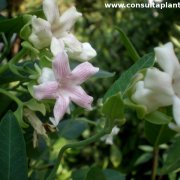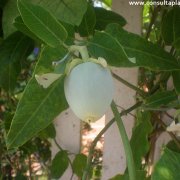Care of the climbing plant Araujia sericifera or Cruel vine |
|
The Araujia genus, Apocynaceae family, comprises 7 species of perennial plants native to South America. Some species are: Araujia sericifera, Araujia plumosa, Araujia graveolens, Araujia megapotamica, Araujia angustifolia. Common names: Common moth vine, Cruel vine, White bladderflower, False choko. This species is native to Argentina, Brazil and Peru. They are fast-growing climbing plants with latex-rich stems that spiral up to 7 meters (23 feet) in length. The leaves are evergreen, pale green, ovate-oblong in shape and have underside hairs. They produce scented white flowers in a 5-lobed tubular shape that attract butterflies and bees. It is called a cruel plant because the nocturnal butterflies are trapped in the flowers until in the morning they open and are released. They bloom from summer to fall. The fruits are pear-shaped, containing many black seeds covered with long silky hairs. Common moth vine is used to cover walls, pergolas or humid areas of the garden that do not need much maintenance; They also grow well in pots. They are invasive plants so they are prohibited in many countries, especially in Europe. Araujia sericifera can be grown in semi-shade exposures, but prefers full sun to flower abundantly. It is a subtropical plant that does not resist frost; do not expose them to less than 10 ºC (50 ºF). Cruel vine is not demanding on the soil but prefers that it contains organic matter and retains moisture. Water regularly so that the soil is moist but not puddled (especially if grown in a pot). If the plant needs water, it warns us because the leaves become limp. Fertilize with compost or manure in late winter. Prune after flowering to control its growth. False choko is a plant resistant to the usual pests and diseases. White bladderflower propagates from seeds sown in spring or by semi-woody cuttings in late summer. |
Images of the climbing plant Araujia sericifera or Cruel vine |
Find plants
Araujia sericifera or Cruel vine | Care and Growing
© 2025 FavThemes




